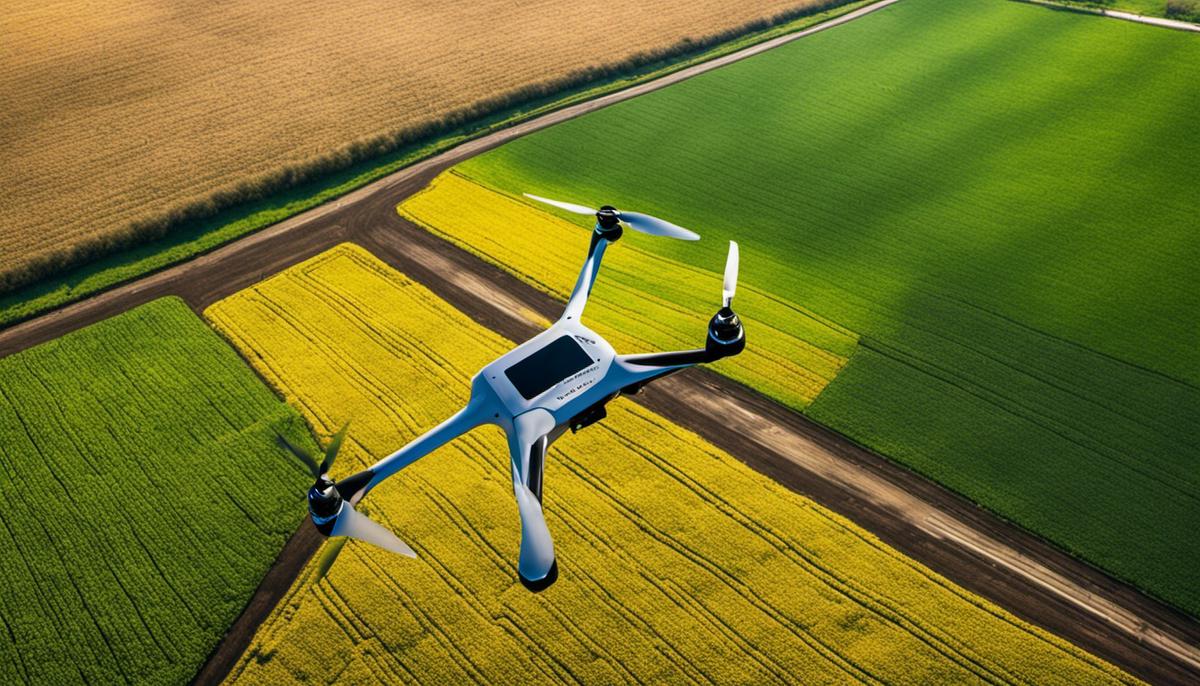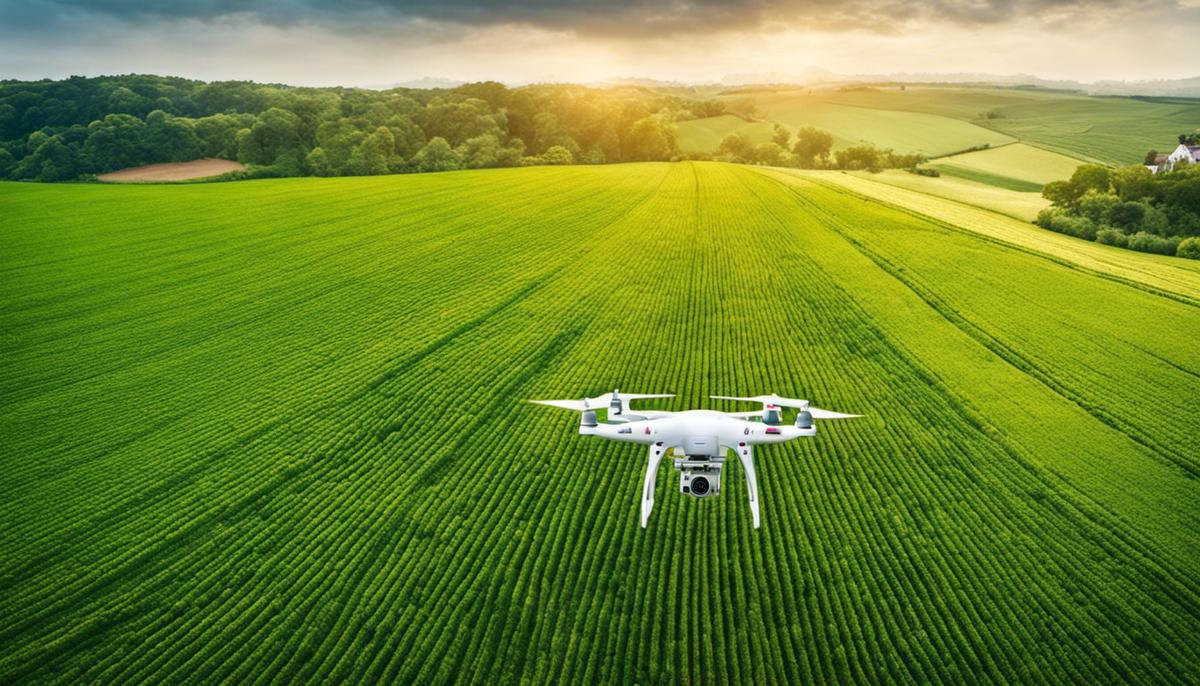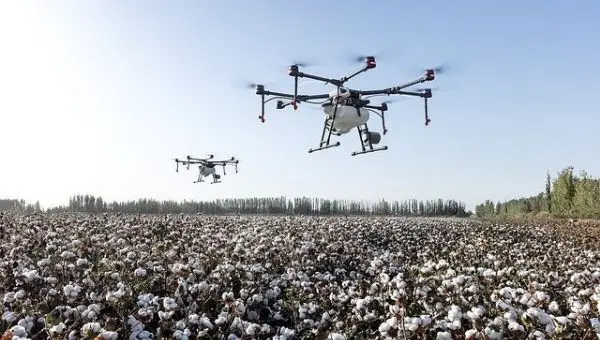
5 Benefits of Drones in Agriculture
Description: In the era of technological advancements, various sectors are utilizing innovative tools to escalate their productivity and efficiency, agriculture being one of them. The advent of drone technology is increasingly exhibiting its prowess in transforming traditional farming practices. The in-depth understanding of drone applicability in agriculture - from monitoring crops, analyzing the soil, and managing irrigation to applying pesticides precisely - has unlocked new dimensions of convenience, accuracy, and timeliness. As we delve further into the impact of drones on agriculture, we will explore how these unmanned aerial vehicles cater to a wide range of agricultural needs and create a dynamic shift in farming operations. The integration of drone technology within the agricultural sector has embarked on a revolutionary journey, constituting an immerse shift toward data-driven and mechanized farming practices. This integration has given birth to new dimensions of agricultures, nonpareil to eras when famers till the earth using rudimentary tools. Today's agronomists are leveraging drone technology to optimize crop yields, trace plant diseases, manage resources in real-time, and - quite essentially - reshape agronomic landscapes to aeraulic orchestras of precision and efficiency. Drone technology has brought in its wake the advent of Precision Agriculture, a methodology that targets the application of inputs in an effective manner, reducing costs and environmental toll while augmenting productivity. Precision Agriculture embodies a paradigm shift from blanket treatments of fields to site-specific management. This means that instead of administering uniform quantities of water, fertilizers, or pesticides over a broad portion of land, these inputs are confined to where they are genuinely required. Guided by GPS and drone-derived data, this detail-oriented approach drastically curtails wastage and amplifies crop productivity. Unmanned Aerial Vehicles (UAVs) or drones are instrumental in mapping and monitoring large farmlands, offering superior resolution and flexibility than satellites. Bursting with spectral and thermal sensors, these airborne collectives scout across the landscape, capturing a wealth of data in the form of Normalized Difference Vegetation Index (NDVI) and thermal imagery. By discerning variations in color and heat signatures, these technologies detect plant stress, hydration status, biomass content and potential pest invasions, the knowledge of which enables season-specific, fine-tuned crop management strategies. In tandem with machine learning algorithms, drone imagery informs precise irrigation, optimizing water usage by identifying hyperlocal conditions of soil moisture. The implications for regions plagued by water scarcity are profound, where such fine-tuning can conserve the precious resource. Further, these high-tech scouts expedite crop phenotyping, the process of assessing plant characteristics. They analyze plant height, canopy area, and color, among other traits, enabling plant breeders to make informed decisions for developing strains with enhanced yield and resilience. Drone technology and crop spraying have a fascinating symbiosis. Drones, loaded with sensors and sprayers, discharge pesticides or biocontrol agents when pest-related thermal anomalies are detected. This targeted approach offers superior pest management, mitigating collateral damage to non-target organisms and reducing pesticide exposure to humans. In essence, the relentless innovations in drone technology are revolutionizing agricultural practices. The scalable, data-driven precision conferred by drones has significant implications for the farm-to-fork journey, raising the bar for efficiency, sustainability, and, by extension, global food security. The notion that these flying laboratories will continue to redefine the contours of agriculture, is more resilience than prediction - an unprecedented evolution on the horizon of humanity and its relationship with the land. In light of these advancements, another essential dimension yet to be explored is the critical role drones play in assessing and monitoring crop health. Although their use in agriculture was once considered of marginal value, contemporary evidence attests to their profound potential in transforming the vitality and efficiency of the agricultural sector across the world. In medicine, an early diagnosis is fundamental for successful treatment. Likewise, detecting plant diseases and deficiencies at an early stage is integral to agricultural success. Advanced drone technology infused with multispectral imaging cameras enables the early detection of such anomalies before they manifest into more devastating conditions. The light reflected off fields captured in various spectra, from visible light to near-infrared, is processed into data that is instrumental in identifying unhealthy crops from the early stages. It is essential, however, not to underestimate the transformative properties of hyperspectral cameras. These tools create a much more detailed image by capturing data from hundreds of narrow, adjacent spectral bands. This means that a farmer can identify individual crop species, diseases or water stress that would have been otherwise indiscernible. Beyond early detection, drones also provide the advantage of frequent monitoring. In an ever-evolving agricultural landscape, where crops respond dynamically to the environment, regular crop health data updates are crucial. Unlike traditional methods, drones can operate under most weather conditions and provide high-resolution data, irrespective of the variability in crop conditions. Moreover, drones have paved the way for remote sensing applications in agriculture, allowing comprehensive spatial coverage. Remote sensing can complement ground-based assessments by covering large field surfaces in a short period, thus substantially reducing the time and cost of manual monitoring methods. Furthermore, it enables specific tracking of soil properties and crop conditions in different field sections, supporting spatial variability management within the field – a fundamental aspect of precision agriculture. Looking beyond the present, the future integration of drones with advanced AI algorithms also bears the potential for predictive analytics in agriculture. Through machine learning approaches, different crop disease patterns can be decoded and utilized to predict future outbreaks, helping secure our global food supply and simultaneously enabling farmers to be proactive rather than reactive, an evolutionary shift in crop health management. In conclusion, drones emerge as a versatile tool fostered by technological convergence. They encapsulate a potent amalgamation of benefits in the context of crop health including early detection of diseases and deficiencies, frequent monitoring, remote sensing applications, and prospective predictive modeling. As various stakeholders in the agricultural industry grapple with increasing pressures to meet global food demands sustainably, the allure of drone technology and its multifaceted advantages in maintaining crop health becomes an undeniable reality. The ability of drones to capture high-resolution images, even from hundreds of feet above the ground, cannot be overstressed. Remarkably, the transformative properties of hyperspectral cameras take this utility a notch up. These cameras can capture detailed images of crops across hundreds of spectral bands allowing the identification of plant stress up to two weeks before it becomes visible to the naked eye. It's a documented fact that incessant monitoring aids in progressive farming. And when it comes to drones, their capability for frequent monitoring is simply incomparable to traditional methods. Being high in the skies doesn't mean to be distant; rather, it makes perspective truly comprehensive. This near-constant vigilance gives farmers the unique advantage of time - time to identify issues early, time to rectify problems before they spiral, and time to modify strategies for optimum results. Remote sensing technology further escalates the merits of drone technology. Its applications in agriculture have now traversed beyond surveillance, providing thorough spatial coverage and tracking of soil properties and crop conditions. The data obtained from remote sensing is not merely a record but a rich resource for informed decision-making aimed at enhancing productivity. Interestingly, data is not the culmination; it's the inception of another leap forward - predictive analytics. The integration of drones with advanced AI algorithms piecing together past patterns, present conditions, and future forecasts, has opened up a whole new realm of possibilities. Crop health management now moves past response mechanisms to a proactive model where potential issues can be predicted and preventive measures strategized. To sum it up, drone technology offers a trove of benefits in crop health management. The utility of drones in offering early detection, frequent monitoring, remote sensing, and predictive modeling puts a powerful tool into the hands of the present-day farmer. A tool that promises not just survival in this challenging era of climate change, but the ability to thrive and contribute positively to the global quest for food security. Such unprecedented use of science in support of one of humanity's most ancient practices, farming, is indeed a testament to the infinite possibilities that lie within this symbiosis of man's curiosity and nature's bounty. This feat serves as an exciting prospect for future advancements in precision farming, painting a rosy picture of agriculture's future that is more efficient, sustainable, and capable of addressing global food security challenges. Despite the myriad advantages of integrating drone technology in agriculture, the practical implementation of these machines in the field presents various challenges. Perhaps paramount amongst these are the intricate legal and regulatory frameworks that accompany the use of drones not only in the United States but also on the global arena. Countries have divergent regulations regarding drone flight, including those related to user certification, flight altitudes, and no-fly zones. Skirting these regulations could culminate in hefty penalties and damage the reputation of farming entities. Moreover, the robustness of drone technology to diverse weather conditions and adverse environments remains a subject of considerable debate. For instance, most commercial drones exhibit challenges in operating under strong wind conditions and cannot function optimally during heavy rain, thereby limiting their utility in some geographical locations and seasons. There are ongoing efforts to create weather-resistant drones, but progress remains incremental. The data handling capacity required for drone usage in farming may also be daunting. High-resolution images captured by drones represent a significant volume of data, necessitating substantial storage facilities and potent data processing capabilities. Managing this data, interpreting it, and making real-time decisions based on the findings all necessitate technical expertise, which may be a challenge for some smallholder farmers. Control and safety issues associated with drones warrant attention as well. Mishaps could result in damage to the drones, leading to potential losses. Additionally, drones pose potential risks to other conventional farming machinery and pets, thus calling for keen monitoring and increased precision during operation. Addressing these challenges necessitates concerted efforts from stakeholders in agricultural drone technology, including manufacturers, policymakers, academia, and the farmers themselves. The potential payoff is immense, given the prospective future of drone usage in our farms. The prognosis of drone technology in agriculture remains positive, with projected advancements poised to address current challenges. Research on innovative drone designs that can withstand various weather conditions is underway. There is also an increasing trend in autonomous drones, capable of making smart decisions such as adjusting their course to avoid collisions, which could revolutionize farming significantly. Going forward, cooperation among policymakers, academia, drone manufacturers, and farmers is critical in establishing beneficial regulations that would unlock drones' full potential in farming. This symbiotic collaboration may facilitate a more standardized and fair policy landscape that would nurture the growth of drone-mediated agricultural practices. Moreover, the fusion of drones with advancing technologies such as artificial intelligence and machine learning can yield even more sophisticated systems capable of not just collecting but also deciphering meaningful data. Such advancements would further facilitate the quick identification and mitigation of critical issues, consequently saving resources. Undeniably, drones are primed to be key game players in the future of agriculture. As they continue to evolve, their capacity, efficiency, and effectiveness in precision farming will exponentially improve, driving a promising future for global food security. However, a holistic approach, encompassing technology, policy, and education, is imperative to harness their full potential. While there are identifiable challenges hindering the blanket adaptation of drones in agriculture, from regulatory boundaries to hefty capital requirements and privacy ramifications, the horizon is not all gloom. Our endeavor to understand drone technology's role in agriculture won't be complete without examining the silver linings. Tremendous strides in areas like artificial intelligence and machine learning promise not only to resolve existing impediments but also to revolutionize farming even more. These advanced technologies' capacity to amplify the precision and resources' efficiency is a testament to a promising future for drones in agriculture. This future-oriented view of agricultural drones assures us of a continuing trend towards a more efficient and sustainable agricultural sector. Drones have become a necessity for every field of agriculture, as they are one of the technologies that carry out precision farming operations, and work to improve efficiency, productivity and better crop yields, and also, the use of technology makes profits increase for farmers and investors in the agricultural field, and according to statistics, drones will be worth In the field of agriculture, $ 5 billion by the end of the year 2025, so it is very important, and here we look at 5 Benefits of Drones in Agriculture. Drones can greatly help farmers and agricultural engineers, through the photogrammetry technology of drones, as they can create high-resolution maps and 3D models of agricultural land, and collect the images that were taken, and drones can be equipped with different types of cameras Which can shoot at night and help farmers a lot. It is considered one of the best main benefits of drones, which is reducing the time spent on the task, as drones are used to spray pesticides and spray the crop very quickly, and they can shorten 75% or more of the time used in spraying pesticides, so saving labor is one of the best Savings means. One of the most important reasons for owning drones is that they allow farmers to obtain agricultural data very quickly, and a lot of information about agriculture, and all of these things make the conditions for agriculture to bear fruit better, and through this farmers can improve the total yield of crops. Drones are very safe for farmers, as manually spraying chemicals is a health risk to farmers, and it takes a long time, but with drones, it is very safe and fast as well. Reducing the use of chemicals through targeted and continuous processing, and also as a result of analyzing the data that comes from drones, gives you the best and smart result, and drones can help reduce pollution, clean the environment and help combat climate change.Understanding of Drone Technology in Agriculture

Benefits of Drone Usage in Crop Health Assessment

Drone Technology and Precision Farming
Delving deeper into the scientific advantages of drone technology in precision farming, it's essential to highlight one of the most significant contributions - early detection. Early diagnosis often serves as a backbone to the proficient management of any disease, with agriculture being no exception. Drones playing a pivotal role in tracking and assessing crop health, primarily when equipped with multispectral imaging cameras. These unique apparatuses permit the detection of minor variations in the vigor of plants, essentially providing the earliest indication of potential plant diseases and deficiencies.

Challenges and Future Prospects of Agricultural Drones


5 Benefits of Drones in Agriculture
1. Speed in data acquisition and accurate analysis of cultivation
2.Save time, effort and money
3. Improved Crop Yields
4. Safer Way To Spray Crops
5. Helping Fight Climate Change